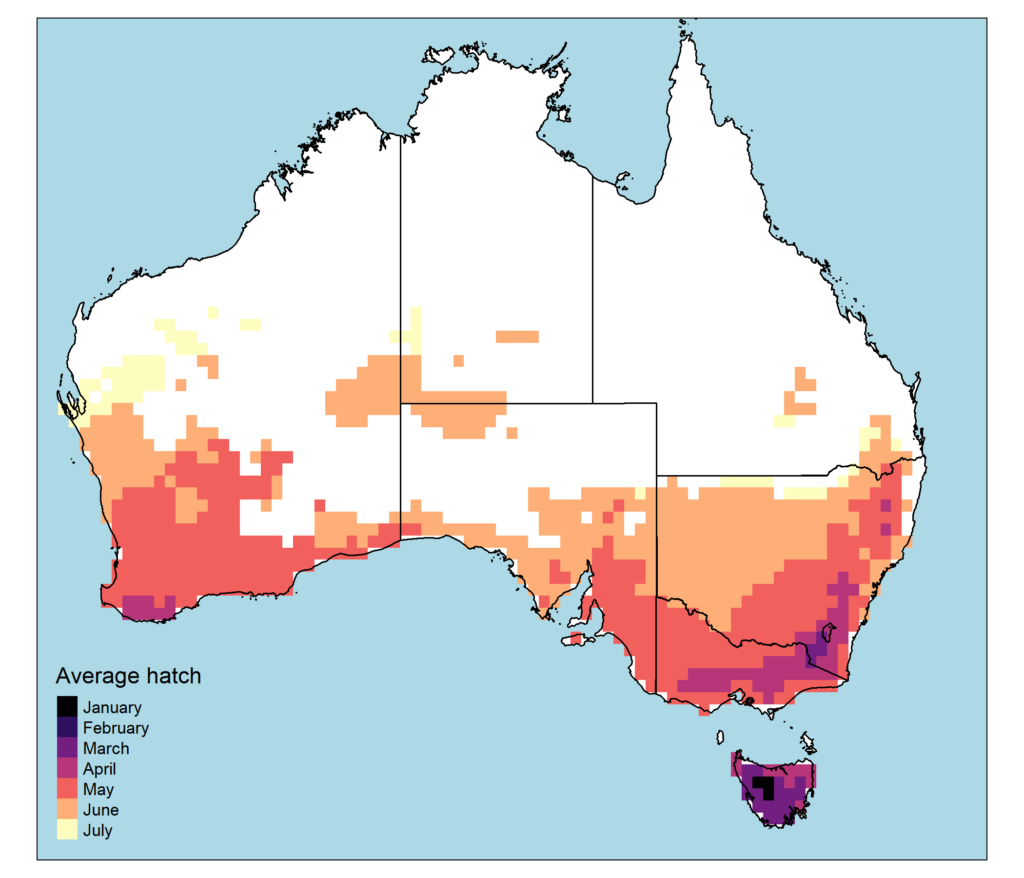Cooler and wetter days are approaching, so it’s time to start thinking about the redlegged earth mite.
Knowing when eggs are likely to hatch is critical for the monitoring and management of this pest in high-risk paddocks.
Our online hatch timing tool uses local climatic data to predict hatch dates, which indicates when to increase crop monitoring. Monitoring for mites can be tricky, but there are useful tips to help you when you are out in the field.
Knowing hatch date improves management
The redlegged earth mite (Halotydeus destructor) can cause significant damage to establishing winter crops and pastures, with the potential for considerable economic loss.
In south-eastern Australia, eggs which have been in diapause in the soil over summer hatch when there is significant rainfall (>5 mm) followed by mean day temperatures below 16°C for 10 days. In paddocks with high risk or a history of heavy redlegged earth mite loads, spraying might be required, and timing is key.
The optimal spray timing in autumn is directly after hatching of the over-summering eggs (in April-May) to protect emerging crop plants.
Remember to only spray if redlegged earth mite numbers reach thresholds to avoid the evolution of resistance and loss of beneficial species. More information on economic thresholds is given below.
Predicting redlegged earth mite hatch dates in your area
Our team has developed a hatch timing tool to optimise monitoring for redlegged earth mite pressure at crop emergence. It predicts when mite eggs will hatch in autumn for the current season.
It estimates the timing of egg hatch in a user-defined location using real-time weather data from the current growing season, and historical data from the past years 25 years.
The map in figure 1 shows the average predicted hatch dates for different regions in Australia. Each colour represents the month in which hatch is predicted to occur. Note that this is the average expectation. Because there is no such thing as an “average year”, the map in figure 2 shows the hatching prediction based on climatic data for the current year.
As shown in figure 2, some areas have already experienced conditions suitable for redlegged earth mite hatching and should be prioritised for monitoring accordingly.
Use the online hatch tool to get more precise predictions for your region in the current season.
Access the redlegged earth mite egg hatch tool


Tips on monitoring
Close monitoring of redlegged earth mite numbers in susceptible crops like canola will indicate the risk of economic damage and the need for management.
It is important to monitor the crop across successive checks during seedling establishment and only spray if economic thresholds are reached. Autumn monitoring is also important as large numbers can overwhelm the protection offered by seed treatments.
Economic thresholds
Economic thresholds for the redlegged earth mite vary across crops, although most is known about canola.
Canola
Cotyledon stage: If mite feeding damage (silvering) affects 20%+ of plants and mites are present treatment is warranted.
1 true leaf stage: >10 mites/plant treatment is warranted.
2 true leaf stage: If there are fewer than 30 plants/m² and the presence of mites, treatment is warranted. If there are more than 30 plants/m² and most plants show no visual mite feeding damage, then do not spray. More than 3 true leaves: There is no benefit in spraying, except when plants are under severe stress (moisture stress or waterlogging) coupled with mite numbers greater than 2000/m².
Nominal thresholds for other crops include (Miles 1996):
Wheat / Barley: 50 mites per 100 cm²
Linseed: 10 mites per 100 cm²
Pulses: 50 mites per 100 cm² Establishing annual medic pastures: 20-30 mites per 100 cm²
Counting mites in the field can be tricky. Here are some useful sampling and monitoring tips for when you’re in the field:
- Try to avoid sampling in sunny conditions or in bright light. Cloudy days, early morning or late afternoon are when mites are most active.
- Mites are best detected feeding on the leaves, however, if mites aren’t observed on the plant material, inspect the soil for mites.
- Visually estimate the number of mites in a 10×10 cm square (100cm2) and repeat the estimates 5-10 times across the paddock.
- If visually estimating mite numbers is not possible, use a standard petrol-powered garden blower/vacuum machine if you have one handy. A fine sieve or stocking is placed over the end of the suction pipe to trap mites vacuumed from plants and the soil surface.
- Look for mite feeding damage on plants. Feeding causes silvering or white discolouration of leaves.
For information on economic thresholds and monitoring, click here.
How to assess redlegged earth mite risk
Use the interactive risk calculator in the lead up to sowing to know to what extent your paddocks are at risk of redlegged earth mite damage. Please note that this tool is still in the draft phase.
The redlegged earth mite best management practice guide also provides a method for assessing redlegged earth mite risk level.
Additional resources
Crop and pasture mite identification video – Cesar Australia
Resistance management strategy for the redlegged earth mite in Australian grains and pastures
Acknowledgements
This web tool was developed by Dr James Maino through a GRDC investment (CES2010-001RXT) with contributions from CSIRO, Cesar Australia, the University of Melbourne, and the Department of Primary Industries and Regional Development.
Cover image: Photo by Andrew Weeks, Cesar Australia





